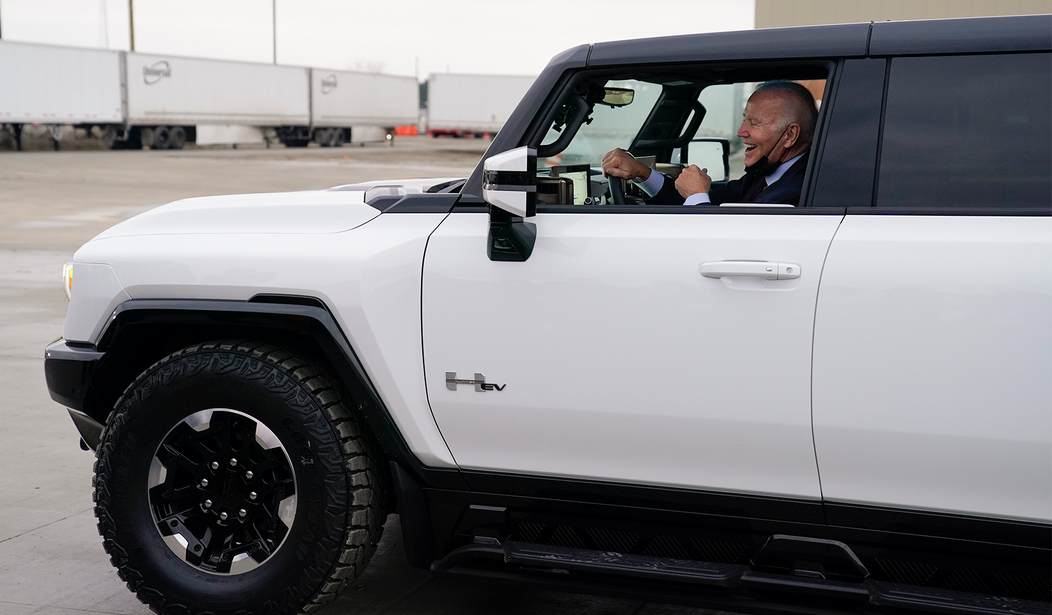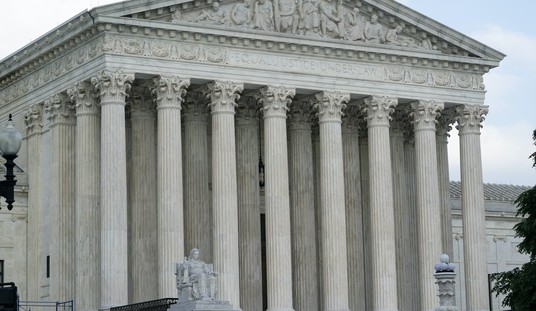Marching under the banner of zero emissions, the Biden administration is embarked on a Great Crusade. At breakneck speed, it aims to bring about a massive transition: forcing the American people—and U.S. automakers—to abandon gas- and diesel-powered cars and trucks and switch to all-electric vehicles (EVs).
EVs set a new record in the first quarter of this year. They accounted for a much-ballyhooed seven percent of U.S. passenger car and pickup sales. Almost half of those vehicles went to consumers with an average annual income of more than $150,000, who said they were eager to jump on the environmental bandwagon. The average income of people who purchased vehicles with internal combustion engines was not even half as much. But they did account for 93 percent of the market.
Under new rules and guidelines, the Environmental Protection Agency wants to ensure that two-thirds of all new passenger cars will be all-electric by 2032. That’s right: up from seven to a commanding 67 percent within the next seven or eight years.
How is that possible? Below the level of top earners, there is deep and widespread consumer resistance, not to mention myriad logistical, technological, and economic challenges.
Undaunted by those challenges, the Biden administration appears fully prepared to kill the traditional auto industry in order to ram electric vehicles down the throats of a great many people who are far from ready to accept them. That’s tens of millions of people who are used to making their own decisions in buying cars and trucks; people who want to get the most value at the lowest cost and are not interested in making any kind of a political statement.
It helps to look at things from their perspective.
For them, the first problem is that the cheapest EVs are still significantly more expensive than equivalent gas-powered cars. At the same time, EVs are ill-equipped to do all the things they expect from their gas-powered cars. That includes not only quick trips and daily commutes to school or the workplace, but also long-distance travel on weekends and family vacations. Relative to what they already have, EVs fall short on convenience, reliability, and comfort.
EV drivers suffer from so-called “range anxiety,” knowing that their electric cars average barely half the distance of gas-powered vehicles in highway driving before they need a “fill-up,” and also knowing that charging stations are not nearly so ubiquitous as gas stations. Most EVs bearing the “Long Range” designation can’t make the 300-mile trip between St. Louis and Chicago without recharging, which can easily add another hour to a four-and-a-half-hour trip. Gas-powered cars and SUVs, which are 20 percent or more cheaper, can easily make the same trip. Unlike EVs, they will also keep a family warm when the outside air is well below freezing and cool when it is extremely hot.
“Naturally,” as Car and Driver said in a recent article, “our first instinct when we climb into a cold car is to crank up the heat. However, in electric vehicles, turning on the heat can’t be an afterthought, because it dramatically impacts efficiency and range.” In gas-powered cars, excess heat from the engine is used to heat the cabin with no loss of efficiency from the engine. They also have an ample supply of on-board energy (a 15-gallon gas tank holds more than six times the stored energy of a fully charged long-range Tesla) that can be used to provide low-cost, efficient cooling. EVs, on the other hand, draw their energy for heating and cooling directly from their batteries. More comfort leaves less energy for propulsion. In cold-weather testing of the Tesla Model 3 Long Range, Car and Driver found that the car’s range when fully heated drops from what it would be in an unheated state by more than 60 miles—to a “meager 173 miles.” But consider the alternative of everyone shivering in a cold car for several hours.
Promises, Promises . . . and Government-created Labor Strife
We come then to the ongoing labor dispute between the United Auto Workers and their primary employers—the Big Three auto companies in Detroit. What went wrong between the union bosses, the corporate bigwigs, and the powers that be in Washington, D.C.?
A falling out among self-interested parties, perhaps, if not quite a falling out among thieves, with each pursuing its own interests at the expense of the others.
President Biden and his administration made a lot of promises to secure the early support of both the union and the companies. There would be lots of “good-paying, union jobs,” extended tax credits of up to $7,500 for people buying EVs, and tens of billions of dollars of loans and subsidies going to the companies for building battery factories, plus big-government investments in new charging stations. When President-elect Biden said, “I believe that we can own the 21st century car market again by moving to electric vehicles,” Mary Barra, the General Motors chief executive, chimed in, saying in a letter sent to leaders of some of the nation’s largest environmental groups: “We at General Motors couldn’t agree more.” His policies, she said, would help to “advance our vision of an all-electric, zero-emissions future.”
There was, however, an iron fist in the velvet glove of all of the nice promises—namely, a rapid tightening of emission controls in the years immediately ahead, to the point that they will effectively outlaw further use of the internal combustion engine and force traditional auto companies to stop selling their most popular and profitable brands. Not to be outdone by the federal government, California has banned all new gas-powered cars by 2035.
The UAW knows very well that its own jobs will be jeopardized if all of the factories producing gas-powered cars and pickups are shut down. Assembly of electric cars involves many fewer parts and fewer workers. GM, Ford, and Chrysler know that they are far behind Tesla and other competitors inside and outside the U.S. in the EV market. They desperately need to sell more of their most popular and profitable brands to be able to compete in the EV market.
Let the Market Decide
In pronouncing a death sentence for the internal combustion engine, the Biden administration and California, its co-enforcer, may destroy the traditional car industry, along with the jobs of its 60,000 unionized workers, even if they are perfectly capable of producing cars that many or even most people want to buy.
Why shouldn’t people have the freedom to buy a car of their own choosing? It isn’t as if the gas-powered cars and trucks at issue here aren’t built to exacting fuel and emissions standards. They are. Do they really represent a serious threat to the environment?
With minimal interference and intervention from high-and-mighty political leaders and bureaucrats, we say: Let producers of gas-powered and electric vehicles compete with one another, and let consumers decide the outcome in a marketplace that provides an abundance of choice. Governments shouldn’t be trying to tip the balance either way with subsidies and coercion.
Why Are We Kidding Ourselves on “Zero Emissions”?
In reality, there are no zero-emission vehicles, not any that are capable of movement. One of the major unaddressed issues in the zero-emissions crusade is where energy will come from to power tens of millions of EVs that are supposed to draw upon the nation’s electrical grid in the next decade. Natural gas and coal currently account for a little more than 60 percent of the nation’s electricity generation at power plants across the country. They could provide a far greater amount, but they won’t because, in addition to championing EVs, the administration is also doing everything it can to shut down domestic oil and gas production. Wind and solar power haven’t turned out to be the magic bullets that people have been talking about for a decade or longer. Despite heavy subsidies, they account for only 13.6 percent of electrical power and are an unreliable source in times of peak demand.
Then there is China to think about. It is both the world’s biggest producer of EVs—the biggest rival to U.S. automakers on that score—and the world’s worst polluter. It is responsible for about 30 percent of the global carbon emissions, compared to 13 percent for the U.S. In recent years, many U.S. utilities have switched from coal-fired plants to natural gas, a much cleaner burning fossil fuel (emitting 50 to 60 percent less carbon dioxide) that suddenly became available because of the fracking revolution that opened up vast quantities of oil and gas on home soil.
Why would anyone give any thought to closing gas plants inside our country while China continues to build dozens of much dirtier coal-fired plants?
If anyone has a good answer to that question, we’d like to hear it.
Andrew Wilson is Senior Writer and Resident Fellow at the Show-Me Institute, where Aaron Hedlund is Chief Economist.














Join the conversation as a VIP Member